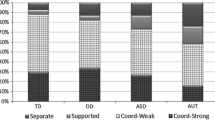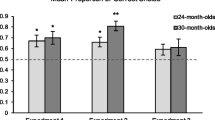Abstract
Examines the ability of young people with autism to generate ideas for play. Young people with autism, children with learning difficulties, and younger normal children were asked to generate 12 different actions and follow 12 instructions with a car and a doll. The young people with autism were impaired, relative to the controls, at generating original actions with the car, but were as able as the controls to follow the instructions. However, the young people with autism were not impaired at generating original actions with the doll. All three groups produced similar amounts of symbolic play. Possible explanations for the difference in results for the two toys are discussed.
Similar content being viewed by others
References
Baron-Cohen, S., Leslie, A. M., & Frith, U. (1985). Does the autistic child have a ‘theory of mind’?Cognition, 21, 37–46.
Boucher, J. (1981). Immediate free recall in early childhood autism: Another point of behavioral similarity with the amnesic syndrome.British Journal of Psychology, 72, 211–215.
Boucher, J. (1988). Word fluency in high-functioning autistic children.Journal of Autism and Developmental Disorders, 18, 637–646.
Boucher, J. (1991). Language profiles in autistic and learning impaired children.Proceedings of International Symposium on Specific Speech and Language Disorders in Children, Harrogate, U.K.
Boucher, J., & Lewis, V. (1989). Memory impairments and communication in relatively able autistic children.Journal of Child Psychology and Psychiatry, 30, 99–122.
Boucher, J., & Lewis, V. (1990). Guessing or creating? A reply to Baron-Cohen.British Journal of Developmental Psychology, 8, 205–206.
Boucher, J., & Warrington, E. K. (1976). Memory deficits in early infantile autism: Some similarities to the amnesic syndrome.British Journal of Psychology, 67, 73–87.
Dunn, L., Dunn, L., Whetton, C., & Pintilie, D. (1982).The British Picture Vocabulary Test. Windsor: NFER-Nelson.
Harris, P. (1990). The work of the imagination. In A. Whiten (Ed.),The emergence of mind-reading. Oxford: Blackwell.
Harris, P. (1993). Pretending and planning. In S. Baron-Cohen, H. Tager-Flusberg, & D. Cohen (Eds.),Understanding other minds. Oxford: Oxford Medical Publications.
Hughes, C., Russell, J., & Robbins, T. (1994). Evidence for executive dysfunction in autism.Neuropsychologia, 32, 477–492.
Huttenlocher, J., & Higgins, E. T. (1978). Issues in the study of symbolic development. In W. A. Collins (Ed.),Minnesota symposia on child psychology (Vol. 11), Hillsdale, NJ: Eribaum.
Jarrold, C, Smith, P., & Boucher, J. (1993).Executive function deficits in the pretend play of children with autism. British Psychological Society Developmental Psychology Section Annual Conference, University of Birmingham.
Jarrold, C., Smith, P., Boucher, J., & Harris, P. (1994). Comprehension of pretense in children with autism.Journal of Autism and Developmental Disorders, 24, 433–455.
Leslie, A. M. (1988). Some implications of pretense for mechanisms underlying the child's theory of mind. In J. W. Astington, P. L. Harris, & D. Olson, (Eds.),Developing theories of mind. New York: Cambridge University Press.
Leslie, A. M. (1993). Rethinking the metarepresentation theory. In S. Baron-Cohen, H. Tager-Flusberg, & D. Cohen (Eds.),Understanding other minds. Oxford: Oxford Medical Publications.
Lewis, V. & Boucher, J. (1988). Spontaneous, instructed and elicited play in relatively able autistic children.British Journal of Developmental Psychology, 6, 325–339.
Lewis, V. & Boucher, J. (1991). Skill, content and generative strategies in autistic children's drawings.British Journal of Developmental Psychology, 9, 393–416.
Ozonoff, S., Pennington, B. F., & Rogers, S. J. (1991). Executive function deficits in high-functioning autistic children: relationship to theory of mind.Journal of Child Psychology and Psychiatry, 32, 1081–1105.
Renfrew, C. (1972).The Action Picture Test. Oxford: C. E. Renfrew, Headington.
Russell, J., Mauthner, N., Sharpe, S., & Tidswell, T. (1991). The ‘windows’ task as a measure of strategic deception in preschoolers and autistic subjects.British Journal of Developmental Psychology, 9, 331–349.
Rutter, M. (1978). Diagnosis and definition of childhood autism.Journal of Autism and Childhood Schizophrenia, 8, 139–161.
Tsai, L., & Beisler, J. (1984). Research in infantile autism: A methodological problem in using language comprehension as the basis for selecting matched controls.Journal of the American Academy of Child Psychiatry, 23, 700–703.
Ungerer, J. A., & Sigman, M. (1981). Symbolic play and language comprehension in autistic children.Journal of the American Academy of Child Psychiatry, 20, 318–337.
Author information
Authors and Affiliations
Additional information
We thank the Mental Health Foundation for financial support for this study and all the children and young people who took part. We are grateful to Rosemary Woolfitt who meticulously transcribed and collated all of the data. Finally, we thank Glyn Collis, at the Department of Psychology at Warwick University, who has given us statistical advice.
Rights and permissions
About this article
Cite this article
Lewis, V., Boucher, J. Generativity in the play of young people with autism. J Autism Dev Disord 25, 105–121 (1995). https://doi.org/10.1007/BF02178499
Issue Date:
DOI: https://doi.org/10.1007/BF02178499




